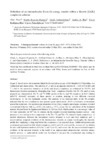Definition of an intramolecular Eu‐to‐Eu energy transfer within a discrete [Eu2L] complex in solution

Use este enlace para citar
http://hdl.handle.net/2183/21323Coleccións
- Investigación (FCIE) [1228]
Metadatos
Mostrar o rexistro completo do ítemTítulo
Definition of an intramolecular Eu‐to‐Eu energy transfer within a discrete [Eu2L] complex in solutionAutor(es)
Data
2012-06-25Cita bibliográfica
Nonat, A. , Regueiro‐Figueroa, M. , Esteban‐Gómez, D. , de Blas, A. , Rodríguez‐Blas, T. , Platas‐Iglesias, C. and Charbonnière, L. J. (2012), Definition of an Intramolecular Eu‐to‐Eu Energy Transfer within a Discrete [Eu2L] Complex in Solution. Chem. Eur. J., 18: 8163–8173.
Resumo
[Abstract] Ligand L, based on two do3a moieties linked by the methylene groups of 6,6′‐dimethyl‐2,2′‐bipyridine, was synthesized and characterized. The addition of Ln salts to an aqueous solution of L (0.01 M Tris‐HCl, pH 7.4) led to the successive formation of [LnL] and [Ln2L] complexes, as evidenced by UV/Vis and fluorescence titration experiments. Homodinuclear [Ln2L] complexes (Ln=Eu, Gd, Tb, Yb, and Lu) were prepared and characterized. The 1H and 13C NMR spectra of the Lu and Yb complexes in D2O solution (pD=7.0) showed C1 symmetry of these species in solution, pointing to two different chemical environments for the two lanthanide cations. The analysis of the chemical shifts of the Yb complex indicated that the two coordination sites present square antiprismatic (SAP) coordination environments around the metal ions. The spectroscopic properties of the [Tb2L] complex upon ligand excitation revealed conventional behavior with τH2O=2.05(1) ms and ϕH2O=51 %, except for the calculation of the hydration number obtained from the luminescent lifetimes in H2O and D2O, which pointed to a non‐integer value of 0.6 water molecules per TbIII ion. In contrast, the Eu complex revealed surprising features such as: 1) the presence of two and up to five components in the 5D0→7F0 and 5D0→7F1 emission bands, respectively; 2) marked differences between the normalized spectra obtained in H2O and D2O solutions; and 3) unconventional temporal evolution of the luminescence intensity at certain wavelengths, the intensity profile first displaying a rising step before the occurrence of the expected decay. Additional spectroscopic experiments performed on [Gd2−xEuxL] complexes (x=0.1 and 1.9) confirmed the presence of two distinct Eu sites with hydration numbers of 0 (site I) and 2 (site II), and showed that the unconventional temporal evolution of the emission intensity is the result of an unprecedented intramolecular Eu‐to‐Eu energy-transfer process. A mathematical model was developed to interpret the experimental data, leading to energy‐transfer rates of 0.98 ms−1 for the transfer from the site with q=0 to that with q=2 and vice versa. Hartree–Fock (HF) and density functional theory (DFT) calculations performed at the B3LYP level were used to investigate the conformation of the complex in solution, and to estimate the intermetallic distance, which provided Förster radii (R0) values of 8.1 Å for the energy transfer from site I to site II, and 6.8 Å for the reverse energy transfer. These results represent the first evidence of an intramolecular energy‐transfer equilibrium between two identical lanthanide cations within a discrete molecular complex in solution.
Palabras chave
Energy transfer
Europium
Lanthanides
Luminescence
Macrocyclic ligands
Europium
Lanthanides
Luminescence
Macrocyclic ligands
Versión do editor
Dereitos
This is the peer reviewed version of the following article: Nonat, A. , Regueiro‐Figueroa, M. , Esteban‐Gómez, D. , de Blas, A. , Rodríguez‐Blas, T. , Platas‐Iglesias, C. and Charbonnière, L. J. (2012), Definition of an Intramolecular Eu‐to‐Eu Energy Transfer within a Discrete [Eu2L] Complex in Solution. Chem. Eur. J., 18: 8163–8173, which has been published in final form at https://doi.org/10.1002/chem.201200087. This article may be used for non-commercial purposes in accordance with Wiley Terms and Conditions for Use of Self-Archived Versions.
ISSN
0947-6539
1521-3765
1521-3765





